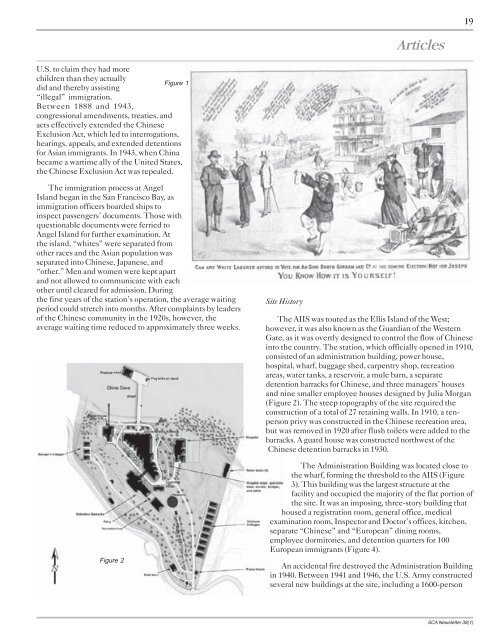March 2004 - Society for California Archaeology
March 2004 - Society for California Archaeology
March 2004 - Society for California Archaeology
Create successful ePaper yourself
Turn your PDF publications into a flip-book with our unique Google optimized e-Paper software.
19<br />
Articles<br />
U.S. to claim they had more<br />
children than they actually<br />
Figure 1<br />
did and thereby assisting<br />
“illegal” immigration.<br />
Between 1888 and 1943,<br />
congressional amendments, treaties, and<br />
acts effectively extended the Chinese<br />
Exclusion Act, which led to interrogations,<br />
hearings, appeals, and extended detentions<br />
<strong>for</strong> Asian immigrants. In 1943, when China<br />
became a wartime ally of the United States,<br />
the Chinese Exclusion Act was repealed.<br />
The immigration process at Angel<br />
Island began in the San Francisco Bay, as<br />
immigration officers boarded ships to<br />
inspect passengers’ documents. Those with<br />
questionable documents were ferried to<br />
Angel Island <strong>for</strong> further examination. At<br />
the island, “whites” were separated from<br />
other races and the Asian population was<br />
separated into Chinese, Japanese, and<br />
“other.” Men and women were kept apart<br />
and not allowed to communicate with each<br />
other until cleared <strong>for</strong> admission. During<br />
the first years of the station’s operation, the average waiting<br />
period could stretch into months. After complaints by leaders<br />
of the Chinese community in the 1920s, however, the<br />
average waiting time reduced to approximately three weeks.<br />
Figure 2<br />
Site History<br />
The AIIS was touted as the Ellis Island of the West;<br />
however, it was also known as the Guardian of the Western<br />
Gate, as it was overtly designed to control the flow of Chinese<br />
into the country. The station, which officially opened in 1910,<br />
consisted of an administration building, power house,<br />
hospital, wharf, baggage shed, carpentry shop, recreation<br />
areas, water tanks, a reservoir, a mule barn, a separate<br />
detention barracks <strong>for</strong> Chinese, and three managers’ houses<br />
and nine smaller employee houses designed by Julia Morgan<br />
(Figure 2). The steep topography of the site required the<br />
construction of a total of 27 retaining walls. In 1910, a tenperson<br />
privy was constructed in the Chinese recreation area,<br />
but was removed in 1920 after flush toilets were added to the<br />
barracks. A guard house was constructed northwest of the<br />
Chinese detention barracks in 1930.<br />
The Administration Building was located close to<br />
the wharf, <strong>for</strong>ming the threshold to the AIIS (Figure<br />
3). This building was the largest structure at the<br />
facility and occupied the majority of the flat portion of<br />
the site. It was an imposing, three-story building that<br />
housed a registration room, general office, medical<br />
examination room, Inspector and Doctor’s offices, kitchen,<br />
separate “Chinese” and “European” dining rooms,<br />
employee dormitories, and detention quarters <strong>for</strong> 100<br />
European immigrants (Figure 4).<br />
An accidental fire destroyed the Administration Building<br />
in 1940. Between 1941 and 1946, the U.S. Army constructed<br />
several new buildings at the site, including a 1600-person<br />
SCA Newsletter 38(1)

















